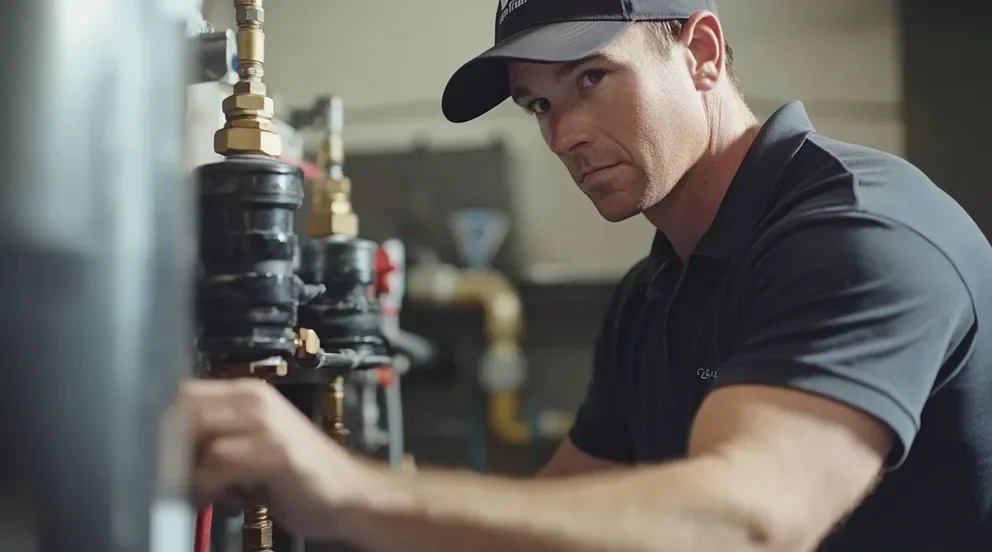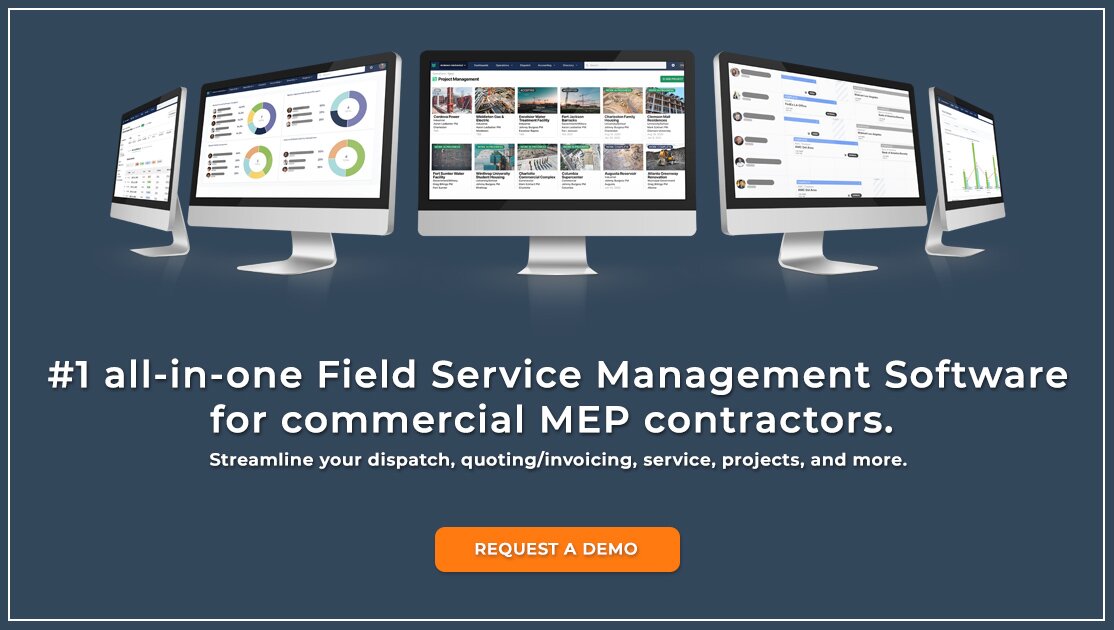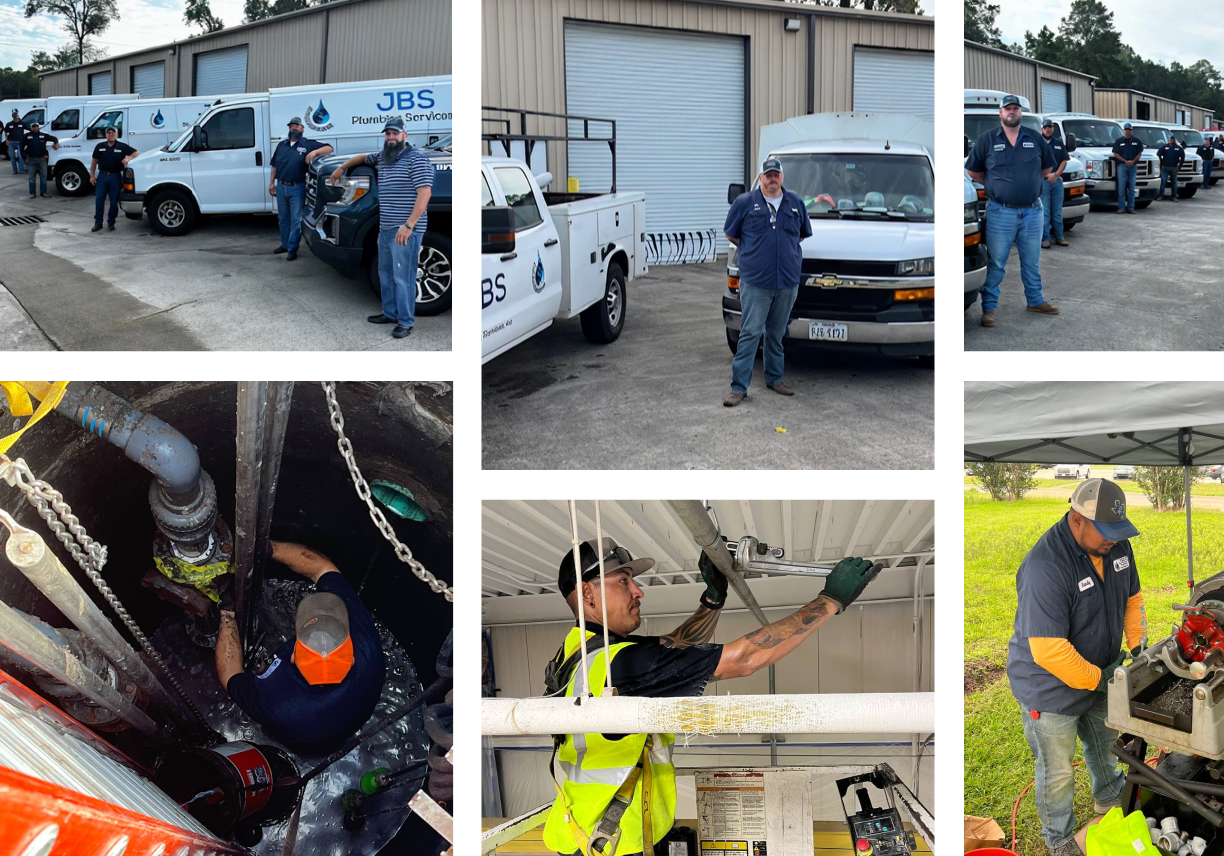You’ve got a full calendar, techs in the field, quotes going out, and service calls stacking up. Keeping track of it all—jobs, invoices, parts, crew schedules—gets messy fast. And when those details live in separate apps, outdated spreadsheets, or worse, on a whiteboard in the back office, things slip. Customers get missed. Hours go unbilled. Jobs take longer than they should.
That’s where plumbing contractor software makes a real difference. It brings everything into one place—from dispatch and time tracking to quoting, job history, inventory, and billing. If you're part of the plumbing industry, it’s the tool that keeps your business moving even when the day’s packed. Here’s what we’re covering:
- How to choose the right software for plumbing contractors
- 14 key plumbing contractor software features to look for
- 12 best plumbing contractor software and tools
- 7 benefits of using plumbing contractor software
- 4 common plumbing contractor software FAQs
Let’s kick off with what matters most—choosing software that fits how your plumbing team actually works.
How to choose the right software for plumbing contractors
Choosing software for a plumbing business means finding a platform that fits the way your team actually works—on job sites, in trucks, and at the office. Whether you're running a lean crew or dispatching multiple teams across the city, plumbing contractor software helps manage scheduling, quoting, job tracking, and billing—all from one place that keeps the business moving without the usual friction. Start by asking the questions that matter most to your daily grind.
- Job volume & crew size – Do we handle enough service calls or projects to justify investing in software? Will this platform scale with us as we grow or add techs to the team?
- Field communication needs – Can our field techs easily access job details from the road? Do we need real-time updates between office staff and crews in the field?
- Office workflow – How do we currently handle scheduling, invoicing, and quoting—are those processes slowing us down? Are we doubling work between the field and back office?
- Customer expectations – Are we getting pushback on response times or billing accuracy? Would customers notice faster turnaround and clearer communication?
- Features – Does the software cover all the major areas we need—dispatching, quoting, time tracking, and job costing? Will it replace multiple disconnected tools with a single platform?
Once these basics are covered, it’s time to look at the features that truly support the way plumbing contractors get work done—whether it's managing jobs, tracking time, or handling service agreements. Let’s dive into the key capabilities next.
14 key plumbing contractor software features to look for
Plumbing work runs on precision—schedules, job details, parts, and people all have to line up. That’s why plumbing contractor software should cover more than just digital paperwork. It needs to connect your field team to your office, track jobs in real time, and help you run a leaner, more profitable operation without losing sight of the work that’s actually happening.
We’ve broken these features into three categories, each one designed to support a different side of your business:
- Project & field service management features like scheduling, dispatching, mobile access for techs
- CRM & sales management features like lead tracking, quoting, invoicing, billing, and payments
- Plumbing system design & simulation features for designing, installing, and maintaining plumbing systems and fixtures
Let’s start with the features that keep jobs moving in the field.
Project & field service management features
Plumbing contractors deal with a lot of moving parts—literally and logistically. You’ve got teams out in the field, schedules shifting by the hour, and customers expecting fast, clean service. To keep up, you need field service management software features that gives your office and field teams full visibility into the work—who’s on the job, what’s done, and what’s still pending.
This group of features handles the core of day-to-day operations: scheduling, dispatching, field communication, and job tracking.
Here’s what to look for:
- Scheduling – Whether you’re dispatching three techs or thirty, field service scheduling tools help you assign the right job to the right person—based on skillset, location, and availability. No more double-booked techs or last-minute reshuffles that throw your whole day off.
- Dispatching – Real-time plumbing dispatch software gives your team a live look at every job and every truck. When something changes—an emergency comes in, a tech finishes early—you can adjust fast and send the closest qualified plumber with the right gear.
- Mobile app – Your techs shouldn’t have to call the office for job details or drive back just to close out work. A technician mobile app puts everything in their pocket—service history, photos, checklists, and signatures—so they can get the job done without delays.
- Reporting and analytics – Guesswork doesn’t cut it when you’re running a business. Reporting tools built for contractors help you track labor costs, job completion rates, technician performance, and revenue trends—so you can make smart calls backed by real numbers.
- Service agreements – If your business handles preventative maintenance or long-term clients, you need a system that tracks contracts and flags upcoming visits. Service agreement software keeps you organized and helps turn maintenance into consistent, reliable income.
- Time tracking – Manual timecards lead to payroll errors and wasted admin hours. Time tracking software lets techs clock in and out from the field with just a few taps—giving your back office real-time labor data for every job.
When the field runs smoothly, everything else follows. But plumbing contractors also need to stay sharp on the business side—tracking leads, closing deals, and getting paid on time. That’s where CRM and sales management features step in. Let’s take a look at how those tools help keep the revenue flowing.
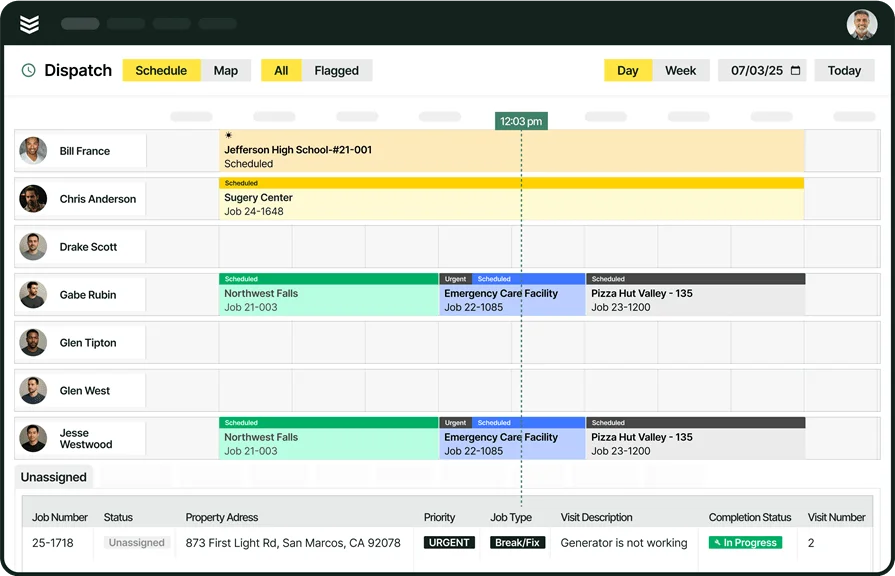
Project management for plumbers
We help plumbers manage projects from the first quote to closeout.
CRM & sales management features
Chasing leads, building quotes, collecting payments—none of it happens on the jobsite, but it’s just as important as the work your techs are doing in the field. For plumbing contractors, these tasks often fall through the cracks when handled manually or across disconnected tools. This is where plumbing software for contractors steps in, keeping your sales pipeline organized and your cash flow consistent. If you’re looking for a deep dive, our CRM guide for plumbers covers everything in detail.
Here’s what to look for:
- CRM – A purpose-built CRM for commercial contractors gives plumbers visibility into every customer, every quote, and every follow-up. Whether you're handling a first-time call or a longtime service agreement, your team can track communication, job history, and upcoming opportunities in one place—no sticky notes or forgotten callbacks.
- Quoting and estimating – Plumbing work moves fast. With quoting software built for plumbing contractors, you can send accurate estimates on the fly, use preloaded parts and labor rates, and respond to bid requests before someone else does.
- Invoicing and payments – Whether it’s a quick repair or a multi-day install, clean and timely billing matters. Plumbing invoicing tools and payment processing features let you generate invoices the moment a job wraps up—and give customers flexible, professional ways to pay.
- Lead generation – Every job starts with a lead, and every lead needs to be tracked. With plumbing lead management software, your office staff can capture and assign new jobs the moment they come in—keeping sales from slipping through the cracks when things get busy.
While sales and billing keep the business running, some shops also take on planning and system layout work that demands a different kind of toolset. That’s where design and simulation features come into play—especially for teams handling larger installs or custom builds. Let’s break down what those tools offer and when they’re worth adding to your software stack.
Plumbing system design & simulation features
Not every plumbing shop needs this category of features—but for those handling complex system builds, large-scale installs, or frequent custom work, these tools are essential. They help plan ahead, control material costs, and stay accurate from the first sketch to the final invoice. These features are more specialized but can be a big advantage for contractors tackling design-heavy jobs or commercial projects.
Here’s what to look for:
- Design – For contractors building out full systems or working on commercial jobs, digital design tools provide accurate layouts, pipe runs, and fixture placements. They make sure your installs meet spec before you ever cut pipe—reducing mistakes and rework.
- Inventory management – Knowing what’s in stock, what’s in the truck, and what needs ordering matters. Good inventory tools let you track parts across multiple locations so you’re not overbuying or showing up to a job without the materials.
- Flat rate pricing – Pre-built flat rate menus give techs a faster way to quote work and keep pricing consistent across jobs. It’s a win for both office staff and customers—cutting down on back-and-forth while protecting your margins.
- Time and materials – For jobs where scope can change on the fly, time and materials tracking gives you flexible billing without the guesswork. It helps your team log hours and parts in real time—so invoices are accurate and disputes are rare.
When these specialized features line up with the work your team handles, they can cut complexity in half and make your bids more competitive. Now that we’ve covered the critical features, let’s break down the top plumbing contractor software and tools on the market—and which ones are best for your business.
12 best plumbing contractor software and tools
With so many tools on the market, it’s easy to get overwhelmed. That’s why we’ve broken this list into focused categories—so you can find what fits your needs without the guesswork. Whether you’re looking for faster scheduling, stronger customer management, or better design capabilities, there’s a tool built for it.
Here’s how we’ve grouped them:
- FSM & project management
- CRM & sales
- System design architecture & simulation
These categories reflect the core functions plumbing contractors rely on—day in and day out.
Best FSM & project management plumbing software
Plumbing contractors live and die by the schedule. Managing crews, jobs, and equipment takes serious coordination—and generic tools just don’t cut it. FSM (field service management) and project management software designed for plumbing helps keep every part of the job moving without the chaos.
1. Best for commercial: BuildOps
BuildOps is built specifically for commercial contractors who manage multiple teams, large-scale jobs, and fast-moving service calls. It brings scheduling, dispatch, job tracking, quoting, and field communication into one clean interface—so your office and field crew are always in sync. With real-time visibility, drag-and-drop dispatching, and mobile tools built for techs, BuildOps is tailor-made for the way plumbing contractors actually work.
How pricing works: BuildOps uses a custom pricing model based on your business size and needs. You’ll need to request a demo to get tailored details.
What sets it apart: This isn’t just a scheduling tool. It’s an all-in-one platform that covers the full job lifecycle—from the initial request to payment collection. It’s especially strong for contractors doing commercial work where coordination, compliance, and repeat service are critical.
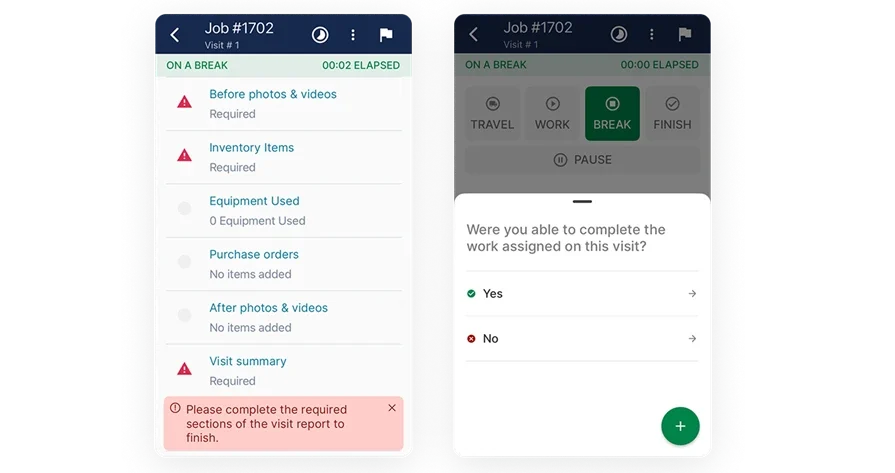
Want to see BuildOps in action?
We help commercial contractors keep their team moving and jobs profitable.
2. Best for residential: Housecall Pro
Image Source: Housecall Pro
Housecall Pro is popular with residential plumbers thanks to its easy setup, mobile-friendly interface, and built-in features like online booking, customer texting, and basic dispatching. It’s great for smaller operations that want to automate customer communication and streamline job tracking without needing a full back-office system. However, it may fall short for commercial contractors who need deeper reporting, multi-tech coordination, or more control over large-scale projects.
How pricing works: Starts around $59/month for basic plans, with premium features available in higher tiers.
What sets it apart: Clean interface, fast onboarding, and strong customer communication tools make it a go-to for solo plumbers and small teams.
3. Best for general contractors: Jobber
Image Source: Jobber
Jobber blends scheduling, quoting, and client management into one platform, and it’s especially strong for companies that handle mixed service types—not just plumbing. It supports real-time dispatch, client portals, and automated follow-ups that can help keep your business top of mind. That said, its generalist focus means it may not include plumbing-specific workflows or integrations that larger trade-focused software offers.
How pricing works: Tiered pricing starting around $25/month for one user, with higher plans unlocking automation and reporting features.
What sets it apart: Great for service businesses managing various trades who need basic plumbing capabilities without committing to niche platforms.
4. Best for small to mid-sized businesses: Workiz
Image Source: Workiz
Workiz is built for growing field service companies and offers features like call tracking, online booking, scheduling, and payment processing. It’s intuitive and designed to help smaller teams scale without adding admin complexity. Still, it may lack the customization and advanced reporting that larger plumbing contractors rely on for high-volume or commercial work.
How pricing works: Starts at $45/month per user, with tiered options for additional features.
What sets it apart: Affordable, easy to learn, and packed with tools designed for businesses in growth mode.
CRM & sales management plumbing software
When the phone rings, it kicks off a chain of events: quoting, scheduling, invoicing, and follow-up. CRM and sales tools help plumbing contractors stay on top of every customer interaction—whether you’re chasing new leads or managing long-term clients. These platforms focus on pipeline visibility, quoting accuracy, and faster cash collection. The right one depends on how you sell, who you serve, and how fast your team moves.
5. Best for on-the-go plumbers: Monday
Monday offers a flexible CRM setup ideal for mobile teams who need to manage sales and customer communication while in the field. It’s customizable and visually clean, with automation that fits solo operators or small service teams handling residential work. However, Monday lacks plumbing-specific workflows out of the box, which can lead to more setup time or workarounds for service-heavy shops.
How pricing works: Starts around $10–16 per user/month, with higher tiers unlocking automation and integrations.
What sets it apart: Its flexibility and mobile accessibility make it a strong fit for plumbing businesses that need a lightweight sales system.
6. Best for bid management: Pipeline CRM
Pipeline CRM focuses on managing sales pipelines and tracking deals from first contact through close. It’s ideal for plumbing contractors who submit a high volume of proposals and want a better way to organize sales activity. But it’s not a field-first platform—so you’ll likely need to pair it with another tool for dispatch, job tracking, or technician coordination.
How pricing works: Starts at $25/month per user with scalable plans for teams.
What sets it apart: Simple and visual pipeline views make it easy to see where every job quote stands in your sales process.
7. Best for scaling businesses: FieldPulse
FieldPulse offers a full-featured platform for field service businesses looking to grow. It includes estimating, dispatch, invoicing, and CRM features all in one, making it easier for small shops to scale up without juggling multiple tools. Still, some plumbing contractors report limited customizability and fewer advanced features compared to larger, more specialized platforms.
How pricing works: Starts at $99/month for a single user, plus $30/month per additional tech.
What sets it apart: Strong all-in-one value and ease of use for companies transitioning from manual processes to full software adoption.
8. Best for end-to-end customer management: LANA Software
LANA software helps service businesses manage every customer touchpoint—scheduling, communication, and follow-ups are all built in. It’s a solid option for residential plumbers looking to improve their customer experience from start to finish. However, its focus is broader across industries, which can limit how well it supports plumbing-specific job workflows or commercial service needs.
How pricing works: Custom quotes based on company size and usage—no public pricing listed.
What sets it apart: Designed to handle the entire customer lifecycle with simple tools that help you stay connected and responsive.
System design architecture, & simulation plumbing software
These tools aren’t for every plumbing business—but if your team handles high-volume takeoffs, detailed system layouts, or compliance-driven installs, design and simulation software can give you a serious edge. Whether it’s quoting from blueprints or meeting strict code requirements, this category focuses on speed, accuracy, and precision.
9. Best for fast takeoff and quoting: PlumbingCAD
PlumbingCAD specializes in creating fast, accurate plumbing system layouts with built-in takeoff functionality. It’s useful for contractors who work from technical drawings and need to generate material lists quickly and accurately. Still, it’s primarily a design tool, not a full business management platform—so you’ll need other software to handle scheduling, dispatch, or invoicing.
How pricing works: Pricing varies by version and features; licenses are typically sold as a one-time purchase.
What sets it apart: Extremely precise and ideal for contractors handling large, spec-driven jobs with fast turnaround demands.
10. Best for plumbing system compliance: H2X
H2X helps ensure your plumbing designs meet regulatory codes, using smart features that catch errors before installation begins. It’s a strong fit for commercial plumbing firms working on jobs with strict compliance requirements. However, the learning curve may be steep for small shops or residential teams without dedicated design staff.
How pricing works: Custom quotes based on usage and business type.
What sets it apart: Built-in code compliance checks make it a great option for firms working on large-scale or highly regulated projects.
11. Best for contractors looking at a budget option: Wondershare EdrawMax
Wondershare EdrawMax is a general-purpose diagram tool that includes plumbing templates—perfect for visualizing layouts without breaking the bank. It’s great for small contractors needing a low-cost, no-frills way to create basic designs.That said, it lacks the depth, automation, and plumbing-specific intelligence offered by pro-level design tools.
How pricing works: Free download available; premium plans offer added features.
What sets it apart: Affordable, accessible, and simple to use—ideal for contractors testing the waters with digital planning tools.
12. Best for fast technical plumbing drawing: Rayon
Rayon is a modern drawing tool built for speed and collaboration, offering a cloud-based interface for creating technical plumbing diagrams. It’s lightweight, fast, and great for teams that want to share drawings in real time. But as a general technical drawing tool, it may lack plumbing-specific features like pipe sizing, code compliance, or takeoff generation.
How pricing works: Free plan available; paid versions unlock more export and sharing features.
What sets it apart: Clean interface and real-time collaboration make it a strong option for fast-paced design work.
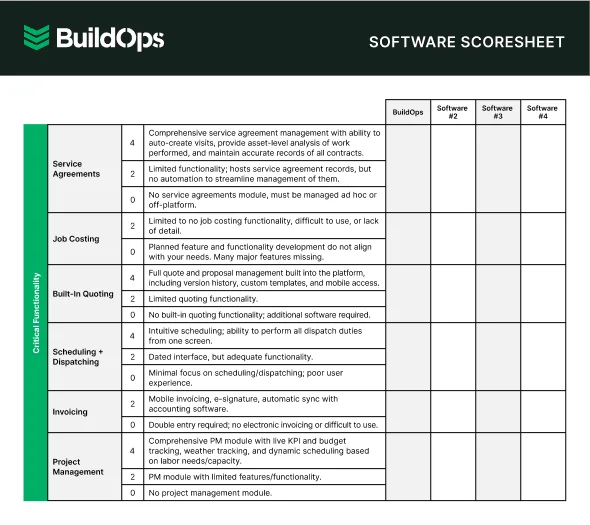
Get the software scoresheet
Compare leading tools at a glance with this easy-to-use scoresheet.
7 benefits of using plumbing contractor software
For plumbing contractors, every delay, missed invoice, or scheduling hiccup adds up. Software built for your trade doesn’t just digitize your workflow—it solves real problems that slow your team down and cut into profits. Whether you’re managing crews, quoting jobs, or collecting payments, plumbing contractor software keeps everything on track and easy to manage. Here’s what it actually helps you do:
For plumbing contractors, every delay, missed invoice, or scheduling hiccup adds up. Software designed for the trade helps eliminate the everyday friction that slows jobs down and chips away at profit. From the first service call to the final payment, it gives your team structure, speed, and clarity across the board.
1. Faster job scheduling and dispatching
Coordinating multiple jobs, techs, and trucks can get out of hand fast. With field service management tools, dispatchers can assign work based on availability and location, shift schedules when priorities change, and make sure no job gets missed. Crews get their updates in real time, and the office sees it all from one screen—streamlining everything from routing to technician performance. Mastering field service management for plumbing contractors gives a clear view into how this works on the ground.
2. Accurate, automated invoicing
Manual billing often leads to late payments, missed charges, and back-and-forth with customers. Plumbing contractor software can trigger invoices the moment a job is marked complete, using preset rates and logged hours to calculate totals instantly. Mobile invoicing helps reduce admin work and keeps cash flowing. More on how invoicing works in the plumbing invoice app.
3. Better visibility into the business
Real-time dashboards and job performance tracking give owners and managers a clearer view of what’s working. Instead of digging through spreadsheets or handwritten logs, everything from job durations to labor costs is already logged and organized.
4. Professional-looking quotes and documents
When estimates and invoices look polished and consistent, it builds confidence with customers. Plumbing software helps generate documents that match your brand, include line-item pricing, and can be sent out in seconds—no extra design or editing work required.
5. Consistent growth tracking
Growth isn’t just about booking more jobs. It's also about improving how those jobs get done. With historical job data and performance trends, contractors can see where they’re improving, where they’re losing time, and how team output changes over time. Recent plumbing company growth data outlines some of the patterns seen across the industry.
6. Fewer dropped jobs and missed steps
From missed signatures to forgotten add-ons, small errors can create big headaches. With structured workflows, digital checklists, and real-time job updates, techs can complete work with fewer mistakes and less guesswork—especially when moving between multiple jobs in a day.
7. On-the-go access for techs
Mobile access means techs don’t have to stop what they’re doing to call dispatch or hunt for paperwork. They can check in on job notes, track hours, upload photos, and close out work—all from the field. It keeps them moving and reduces time lost to miscommunication.
4 common plumbing contractor software FAQs
Switching to new software comes with a lot of questions—especially when it impacts your entire operation. From how it works in the field to whether it’s worth the investment, plumbing contractors need straightforward answers. Here are some of the most common questions that come up before making the move.
1. What is plumbing contractor software?
Plumbing contractor software is a digital tool that helps manage core operations like scheduling, dispatching, quoting, invoicing, and field communication—built specifically for the needs of plumbing businesses. It helps teams stay organized, reduce paperwork, and run jobs more efficiently.
This type of software is different from general business tools because it supports the real-world workflows plumbers deal with every day—things like assigning the closest tech to an emergency job, tracking materials used on-site, and syncing office and field teams in real time. Some platforms include mobile access, customer communication tools, and built-in reporting so you can make better decisions with less guesswork.
2. How does software for plumbing contractors work?
Plumbing contractor software connects your field and office teams through a single digital platform. Most systems include a desktop dashboard for dispatchers and managers, plus a mobile app for technicians in the field.
Here’s how it typically works:
- Dispatchers assign jobs using a drag-and-drop calendar or live dispatch board
- Techs receive work orders on their mobile device, complete tasks, upload photos, and log time
- The system tracks job progress, generates invoices, and updates customer records automatically
- Office staff can monitor schedules, view completed work, and manage payments in real time
Everything stays in sync, which helps reduce double entry, missed steps, and delays.
3. Is software worth the cost for plumbing contractors?
For most plumbing contractors, yes—especially those juggling multiple crews or service calls each day. The upfront investment pays off through faster invoicing, better job tracking, and fewer errors. When your techs are in and out of jobs more efficiently and your billing is automated, that time and labor savings add up fast.
It’s also about minimizing risk. Miscommunication, missed jobs, and unbilled hours can quietly erode profit margins. A purpose-built platform helps prevent those leaks by giving the whole team visibility and control over the work happening in real time.
4. Best practices for implementing plumbing contractor software
Rolling out new software can be disruptive—but with the right steps, it can also be one of the easiest upgrades you make. Implementation is less about learning a new tool and more about aligning your team to a better way of working.
Here are best practices to make the transition smoother:
- Assign an internal point person to manage the rollout
- Involve both office staff and field techs in early testing
- Start with core features first (e.g., scheduling and invoicing) before introducing more
- Clean up your customer and job data before migrating to the new system
- Set realistic goals and timelines for onboarding
- Provide hands-on training—not just manuals or videos
- Choose a vendor with responsive support and onboarding assistance
- Get early feedback from the team and adjust where needed
- Monitor KPIs like job duration, invoice time, and customer satisfaction after launch
The goal isn’t perfection on day one—it’s setting your crew up to succeed with the right tools at the right pace.
Plumbing work is demanding enough without chasing paperwork, fixing miscommunications, or juggling five different systems to manage your day. That’s why software built specifically for plumbing contractors matters—it ties everything together, from scheduling and dispatch to invoicing, quoting, and field updates.
Most platforms only cover part of the job. But for commercial contractors handling fast-moving service calls, install work, and multiple crews, having one platform to manage it all can be a real edge. BuildOps supports that full workflow—equipped with features that aren't common in other tools, especially when it comes to commercial field service.
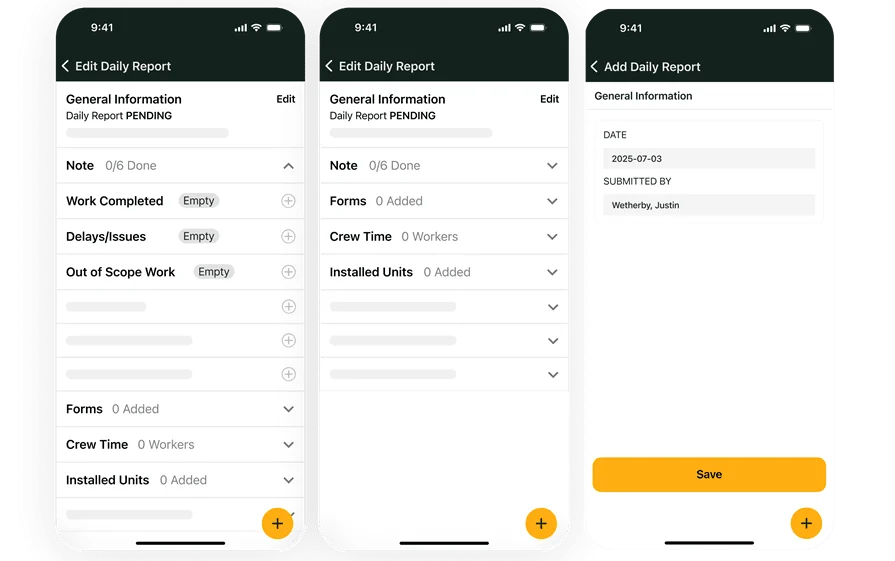
See how BuildOps handles jobs
We help plumbers book more jobs, track progress, and get paid faster.
